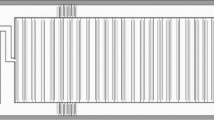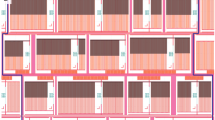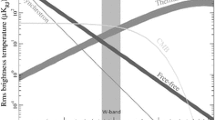Abstract
The next generation of far infrared radiation detectors is aimed to reach photon noise limited performance in space based observatories such as SPICA and BLISS. These detectors operate at loading powers of the astronomical signal of a few Attowatt (10−18 W) or less, corresponding to a sensitivity expressed in noise equivalent power as low as \(\mathrm{NEP} = 2\times10^{-20}\ \mbox{W}/\sqrt{\mathrm{Hz}}\). We have developed a cryogenic test setup for microwave Kinetic Inductance Detectors (MKIDs) that aims to reach these ultra-low background levels. Stray light is stopped by using a box in a box design with a sample holder inside another closed box. Microwave signals for the MKID readout enters the outer box through custom made coax cable filters. The stray light loading per pixel is estimated to be less than 60×10−18 W during nominal operation, a number limited by the intrinsic sensitivity of the MKIDs used to validate the system.
Similar content being viewed by others
Avoid common mistakes on your manuscript.
1 Introduction
Future space borne observatories for the far infrared and sub-mm (30 μm to 3 mm) will move in the direction of detection limited solely by the background emission from the universe [1]. This can only be achieved by building an observatory in which the telescope optics is cooled to 4 K to reduce its emitted flux to levels below the radiative background of space. In this case the power loading the detector for a spectrometer instrument can be as low as P sky ≈0.2×10−18 W, corresponding to a photon noise limited noise equivalent power \(\mathrm{NEP}_{photon} \approx2\times 10^{-20}\ \mathrm{W}/\sqrt{\mathrm{Hz}}\) [1]. In this paper we discuss a light-tight experimental setup designed to reduce the power loading on Microwave Kinetic Inductance Detectors (MKIDs) [2]. The setup described here is also applicable for other detectors and for Quantum electrodynamics experiments, where quasiparticle creation due to stray light results in Quantum decoherence in superconducting Qubits due to stray light [3, 4].
MKIDs are superconducting pair breaking detectors that sense the change in the complex surface impedance of a thin superconducting film due to radiation absorption with a (sky) frequency F in excess of the gap frequency of the superconducting material: F rad >2Δ/h=F gap , with F gap ∼80 GHz for aluminum. A MKID consists of a thin superconducting film that is incorporated in a resonance circuit with a typical resonance frequency of a few GHz [2, 5]. Changes in the surface impedance of the film due to Cooper pair breaking caused by radiation absorption are converted to changes in resonator quality factor and resonance frequency read out at the resonator resonance frequency. For Aluminum MKIDs the fundamental limit in the sensitivity is given by the generation-recombination noise equivalent power NEP G−R which can be as low as \(\mathrm{NEP}_{G-R}\approx 1\times10^{-20}\ \mathrm{W}/\sqrt{\mathrm{Hz}}\) at temperatures T<T c /10 (see Ref. [2]). This very low value is a result of the exponential decrease in quasiparticle number with decreasing temperature. Stray light in the experimental setup with a frequency in excess of F gap will create quasiparticle excitations in the device, preventing MKIDs from reaching their utmost sensitivity and causing decoherence in Qubits.
2 Experimental Details
The cryogenic system we use is a pulsed tube pre-cooled Adiabatic Demagnetization Refrigerator, with a cold stage consisting of a single 20 mm diameter gold plated copper finger surrounded by radiation shields thermally anchored to the pulsed-tube cooled stage of the cooler with a nominal operating temperature of 3.5 K (referred from now on as the 4 K stage). Additionally an intermediate temperature level of 600 mK is available for thermal anchoring. In Ref. [6] we have described a set of experiments to measure and limit stray light loading on MKIDs, but none of the designs tested were immune to stray light from the 4 K stage loading the detectors.
The new design presented here is based upon a ‘box in a box’ principle, with a light tight sample holder inside a light tight outer box as shown in Fig. 1. Connection to the readout electronics is achieved by means of feed-through coax filters glued in the outer box using silver loaded epoxy, designed to absorb any radiation traveling through the coax cables. The ‘outer box’ in Fig. 1 is made of gold plated Cu and is closed of with a lid equipped with labyrinths filled with carbon loaded epoxy. A separate carbon-loaded epoxy filled labyrinth with two 2 mm diameter holes that have no direct line of sight contact is used to be able to pump down the outer box, the sample holder itself is also equipped with such a labyrinth. The lid inner side is coated with a ≈3 mm thick radiation absorber made from carbon loaded epoxy with SiC grains of 1 mm [8, 9]. The carbon loaded epoxy consist of 3% by weight lamp black (pure carbon powder) in Epotek-920 epoxy. The absorber needs to be thick to absorb effectively the longest wavelength radiation that can still create quasiparticles (≈3.8 mm for Al). Note that the longer wavelength stray light is harder to absorb: Thicker absorbing layers are required and many materials commonly used as radiation absorber become less effective at longer wavelengths, especially for λ>1 mm [10]. The outer box is equipped with 2 feed-through coax filters that transmit the 3–8 GHz readout signals but absorb stray light at frequencies F>F gap ≈80 GHz. The filters are home-made coaxial cables made from 2 mm inner diameter gold plated Cu tubes and a 0.25 mm Cu wire as inner conductor, which have a lossy dielectric that absorbs the stray light, similar to the design described in Ref. [11]. The dielectric consists of a mixture of 15 gram of black Stycast, with 1.2 gram of 24LV catalysis and 2.8 gram of 0.5 μm diameter sub-micron bronze powder from Canano technologies. The radiation absorption is due to eddy current dissipation in the bronze grains, which becomes effective as soon as the powder size is of the order of the skin depth. Sub-micron bronze powder is expected to give a cut-off frequency in the GHz range [11]. To fabricate the filter we use a microwave cable connector (Radiall R125.055.000) on one side and a 90 degree SMA panel launcher (Radiall R125.462.001 W) on the other side. The stycast-powder mixture is injected using a syringe with the central wire and first connector mounted on the tube and with tension on the wire to keep it well centered. The 90 degree connector is mounted after this step, the result is shown in Fig. 1D. The stycast-bronze powder weight rations were optimized to give ϵ=6.22, which gives a 50 Ω impedance for our coax filter geometry. The filter transmission S21 measured at 300 K is given in Fig. 2A. It shows a single exponential decay as a function of frequency with a characteristic frequency of 10.4 GHz. The functional form of the roll-off indicates a very significant attenuation for stray light radiation at F>80 GHz. The input port reflection parameters (see Fig. 2B) are below −15 dB, which indicates that only −15 dB of power is reflected from either port of the filter when probed with a 50 Ω measurement system. This implies that both ports are well matched to 50 Ω within the 3–8 GHz used to readout the KIDs. The sample holders that we mount inside the light tight box are light tight as well: They have radiation labyrinths with carbon loaded epoxy and a 3 mm thick carbon loaded epoxy absorber with 1 mm SiC grains inside the lid of holder. To enable quasiparticle lifetime measurements with a fast LED pulse as described in Ref. [7] we use a 40 cm long 0.5 mm diameter PMMA (Polymethylmethacrylaat or Perspex) fiber from the LED at 4 K, which is taped to the cold stage for over 20 cm to allow good formalization and absorption of part of the 4 K thermal radiation. Since especially the low frequency part of the thermal radiation is likely to be less good absorbed [10] we use a 150 μm diameter hole inside the outer box lid as 1 THz high pass filer for the LED light: The fiber from the LED is mounted in front of the hole, an identical fiber is mounted at the lid inner side and fed into the sample holder, ending directly above the detectors.
(Color online) (A) Photograph of the outer light tight box, with mounted inside a sample holder with infrared bandpass filters. (B) Coax filter after fabrication, the ring is used for gluing it into the outer box. (C) Cut-out CAD model of the light-tight setup, the cylindrical shape at the bottom of the outer box clamps to the ADR cold finger. (D) The last stage of the coax filter fabrication: We show the central wire soldered to the end connector
(Color online) (A) Measured S21 of one filter at 300 K. The response can be fitted with a single exponential decay. Assuming that the functional form of the filter roll-off holds from 10 to 80 GHz, the attenuation at 80 GHz would be −45 dB. (B) Reflection S parameters of the filter, port 1 corresponds to the upper, 90 degree connector, mounted at the end of the filter fabrication process (see also Fig. 1D). Note the low value of S11 and S22, indicating a good match of the filter to 50Ω
3 Results
To test the full system we mount a MKID chip into a sample holder and mount this inside the outer box, 2 0.86 mm coax cables connect the filters to the holder. The MKIDs are standard 1/2 wavelength coplanar waveguide resonators made of a single Al film of 50 nm thick [12]. The top lid of the cold box and of the sample holder are closed off with a blind flange. We do connect the optical fiber coming from the red LED to the sample holder. We cool the system down and measure the quasiparticle lifetime using the LED pulse method as described in [7] as a function of the 4 K stage temperature [6]. The cold stage remains below 100 mK in this experiment. Since it can be shown that the amount of quasiparticles created in a superconductor N qp due to pair breaking radiation with power P sky is given by [2]:
\(\frac{1}{\tau_{qp}^{2}}\) is a good indicator of the amount of radiation absorbed in the MKIDs. Here, Δ the energy gap of the superconductor, τ qp the quasiparticle lifetime and η=0.57. In Fig. 3A we give the result of this experiment, together with a similar experiment discussed in [6]. In the latter experiment we do not use a ‘box inside the box’ setup, but we mount the same light tight sample holder directly to the cold finger of the fridge and we do use coax cable filters. We observe that with the ‘box inside the box’ setup that there is no change in \(\frac{1}{\tau _{qp}^{2}}\) when the 4 K stage temperature is increased from 3.3 K to 10 K, this in contrast with the single sample holder experiment, where we do observe a clear dependence. We also have performed a control experiment where we used the same chip as in [6] in the ‘box inside the box’ setup. We observe in that case again that \(\frac {1}{\tau_{qp}^{2}}\) does not depend on the 4 K stage temperature. From this measurement we conclude that in the ‘box inside the box’ setup no radiation from the 4 K stage is absorbed by the detectors and the measured τ qp =2.2 msec, is likely limited by other processes.
(Color online) (A) The inverse square of the quasiparticle lifetime (which scales linearly with absorbed power) as a function of the 4 K stage temperature of the fridge, the cold stage remains stable over these measurements. The black squares show no change up to 10 K, indicating that no stray light from the 4 K stage is detected by the MKID. We reproduce the data from the best case of [6] by the red dots. (B) Data reproduced from Ref. [14] indicating the readout power dependence of the quasiparticle lifetime and quasiparticle number, extracted from both the amplitude power spectral density (squares) and the amplitude-phase cross-PSD (triangles). The limiting values of τ=4 msec and N qp =1×104 imply P sky <180×1018 W
Since the MKIDs are not limited by radiation from the 4 K stage surrounding the setup, we can only estimate an upper bound to the stray light from the 4 K stage, assuming that the MKID performance is limited by 4 K stray light. To do this we take the data from Ref. [14] reproduced in Fig. 3B. Here we show the measured quasiparticle number and quasiparticle lifetime as function of MKID readout power. The data indicates that the MKID performance is limited by joule heating due to the readout power. Taking the maximum quasiparticle lifetime and corresponding quasiparticle number (≈1×104 for the whole resonator volume) and using (1) we obtain P sky =0.18×10−15 W at a 4 K stage temperature of 3.5 K. The estimated upped bound of the stray light absorbed per resonator is a factor 3.5/10 lower, as the lifetime is constant up till a temperature of 10 K of the 4 K stage. We thus conclude that the amount of stray radiation per pixel P StrayLight ≤60×10−18 W. This about 5 orders of magnitude lower than the sky loading for a pixel in a ground based sub-mm imaging instrument, but still about a factor 10–100 higher than the loading for a grating spectrometer illuminated by a cryogenically cooled 4 K telescope in space.
As a last experiments we verify the performance of the entire system with a set of band pass filters in stead of blind flanges mounted on the inner and outer cold box. The filters allow a 4–40 K thermal calibration signal to be detected by the KID. We mount a low pass and high pass filter on the outer cold box, defining a 1.3–2.9 THz band pas. On the sample holder we mount a 100 GHz wide band pass filter stack centered at 1.55 THz. A black body radiator with an identical filter stack is mounted above the cold box thermally anchored to the 4 K stage. We mount in the sample holder a lens-antenna coupled MKID array made fully of Al [13] with an antenna design frequency centered at 1.6 THz. The calculated amount of power from the black body on each pixel is about 2×10−20 W at 3.5 K black body temperature. This is negligible so we expect that the experimental system is nominally identical. We indeed observe that the quasiparticle lifetime is identical to the case where the optical access is blocked by blind flanges.
4 Conclusions
We have designed and tested a light tight experimental test setup for use inside an ADR cooler. The design uses a ‘box inside a box’ concept and coax feed-though filters to eliminate stray light from the 4 K environment that surrounds the cold stage. The amount of stray light still entering the system and detected per resonator is lower than we can detect, with a maximum value of about P StrayLight =60×10−18 W. More sensitive detectors are required to more accurately determine the stray light in our system. Note that our cooler is in design quite similar to a typical space based cryogenic system: A cold finger inside a 4 K environment. The design discussed here could be taken as a staring point for the design of such instruments. It is worth mentioning that we have measured the same device presented in Fig. 3 without using the outer box inside a large dilution refrigerator. This fridges (from Leiden cryogenics) is standard equipped with multiple radiation shields at temperatures below 1 K. Using only our light tight sample holder, without using the outer box and without additional coax filters we measure the same quasiparticle lifetime as in our setup, another indication that the main need for the setup described in this paper is caused by the 4 K environment surrounding our cold stage.
References
Detector Needs for Long Wavelength Astrophysics: A Report by the Infrared, Submillimeter, and Millimeter Detector Working Group. http://safir.gsfc.nasa.gov/docs/ISMDWG_final.pdf (2002)
P.K. Day et al., Nature 425 (2003)
R. Barends, J. Wenner, M. Lenander, Y. Chen, R.C. Bialczak, J. Kelly, E. Lucero, P. O’Malley, M. Mariantoni, D. Sank, H. Wang, T.C. White, Y. Yin, J. Zhao, A.N. Cleland, J.M. Martinis, J.J.A. Baselmans, Appl. Phys. Lett. 99, 113507 (2011)
M. Lenander, H. Wang, R.C. Bialczak, E. Lucero, M. Mariantoni, M. Neeley, A.D. O’Connell, D. Sank, M. Weides, J. Wenner, T. Yamamoto, Y. Yin, J. Zhao, A.N. Cleland, J.M. Martinis, Phys. Rev. B 84, 024501 (2011)
S. Doyle, P. Mauskopf, J. Naylon, A. Porch, C. Duncombe, J. Low Temp. Phys. 151, 530–536 (2008)
J. Baselmans, S. Yates, AIP Conf. Proc. 1185, 160–163 (2009)
J. Baselmans, S.J.C. Yates, R. Barends, Y.J.Y. Lankwarden, J.R. Gao, H. Hoevers, T.M. Klapwijk, J. Low Temp. Phys. 151(1–2), 524–529 (2008)
M.C. Diez, T.O. Klaassen et al., in UV, Opt. and IR Space Telescopes and Instr., vol. 4013 (2000), pp. 129–139
P. Hargrave, Nucl. Instrum. Methods Phys. Res., Sect. A, Accel. Spectrom. Detect. Assoc. Equip. 444, 427–431 (2000)
J.W. Lamb, Int. J. Infrared Millim. Waves 17, 12 (1996)
F.P. Milliken et al., Rev. Sci. Instrum. 78, 024701 (2007)
P.J. de Visser, J.J.A. Baselmans, P. Diener, S.J.C. Yates, A. Endo, T.M. Klapwijk, Phys. Rev. Lett. 106, 167004 (2011)
S.J.C. Yates, J.J.A. Baselmans, A. Endo, P. Diener, L. Ferrari, A.M. Baryshev, Appl. Phys. Lett. (2012, submitted)
P.J. de Visser, J.J.A. Baselmans, P. Diener, S.J.C. Yates, A. Endo, T.M. Klapwijk, these proceedings (2011)
Author information
Authors and Affiliations
Corresponding author
Rights and permissions
About this article
Cite this article
Baselmans, J., Yates, S., Diener, P. et al. Ultra Low Background Cryogenic Test Facility for Far-Infrared Radiation Detectors. J Low Temp Phys 167, 360–366 (2012). https://doi.org/10.1007/s10909-012-0511-0
Received:
Accepted:
Published:
Issue Date:
DOI: https://doi.org/10.1007/s10909-012-0511-0







